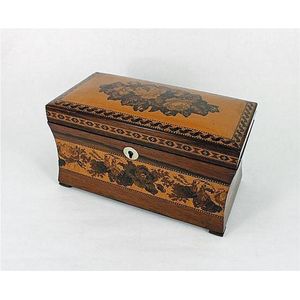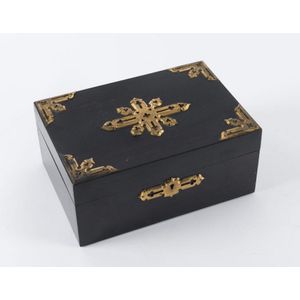Coromandel Jewelry Casket, English, 1840
You must be a subscriber, and be logged in to view price and dealer details.
Subscribe Now to view actual auction price for this item
When you subscribe, you have the option of setting the currency in which to display prices to $Au, $US, $NZ or Stg.
- Calamander / Coromandel - Calamander wood, also known as coromandel wood or coromandel ebony, is a type of hardwood that comes from the Calamander tree (Diospyros quaesita), which is native to Sri Lanka, India, and Southeast Asia. The wood is known for its dark brown or black colour and its distinctive figuring, which can resemble a snakeskin pattern.
The wood is highly prized for its beauty and durability. It is often used in fine furniture making, particularly in the production of inlaid and marquetry work, as well as in the making of boxes, cabinets, and other decorative items. It is also used in the manufacture of flooring, paneling and other architectural applications.
Calamander wood is a very hard and heavy wood, it has a density of around 1.04 g/cm3. Its density and high natural oil content make it resistant to decay and insects, which is why it is a popular choice for outdoor furniture, flooring and other decorative items.
The wood is also used for turning and carving, but is difficult to work due to its high density and interlocking grain. However, it takes a high natural polish and has a beautiful lustre, which is why it is so sought after.
Due to the high demand and over-exploitation of the natural resources, the calamander tree is now a protected species, and the harvesting and export of the wood is heavily regulated. - Circa - A Latin term meaning 'about', often used in the antique trade to give an approximate date for the piece, usually considered to be five years on either side of the circa year. Thus, circa 1900 means the piece was made about 1900, probably between 1895 and 1905. The expression is sometimes abbreviated to c.1900.
This item has been included into following indexes:
Visually similar items

A pine trunk hand painted with flowers on a black ground 68 cm wide, 40 cm deep, 40 cm high

A Victorian Tunbridge ware tea caddy with flower and leaf motifs. Width 22 cm

Regency rosewood and cut brass writing slope with Inkwells impressive detailed brass bound slope of large proportions fitted nicely with two inkwells, and two compartments (one lidded), penrest and green leather writing slope, height 17 cm, width 55 cm, de

'Imperial Cricket', by P.F.Warner [London, 1912], large format, top edge gilt, subscribers' limited edition of 900 copies. Fair/Good condition. Ex MCC Library.
